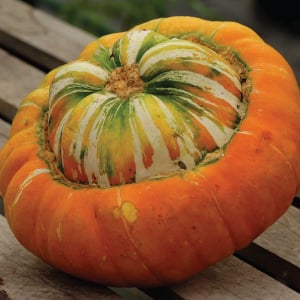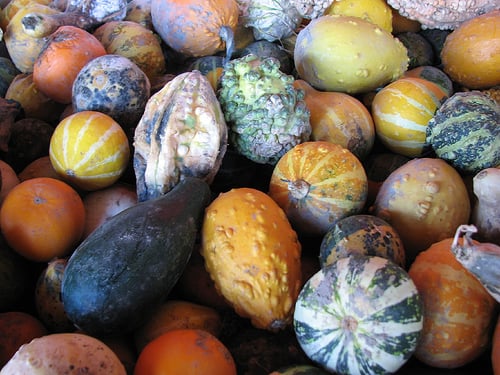
Learning Download: How to Grow Gourds
From Seed to Harvest: A guide to growing gourds.
Gourds can be often used as a natural source of décor during the fall months. Ornamental gourds come in all colors and sizes, and can even be made into birdhouses. Gourds are a member of the squash family.
To plant:
Gourds can be planted directly in the garden in hills or rows. Plant after the last spring frost. For hill planting, sow five seeds per hill with hills spaced 4 feet apart. For planting in rows, sow seeds 5 inches apart in rows set 5 to 10 feet apart. The less overcrowding allows for larger gourds to be grown. Once seedlings appear on the hills, thin to three plants per hill. Gourds prefer warm weather, and although they are used as decoration during cooler months, they do not like frost. A late spring frost when planted can kill the seedlings unless covered.
To grow:
Gourds like full sun and plenty of water, though some gardeners say gourds grow best by neglect, which means to plant them and leave them alone for the season. They also grow well if placed near a fence or trellis, as they are vining plants.
To harvest:
Gourds can take anywhere from 90 to 130 days to harvest based on the variety grown, with hard-shell varieties taking longer to mature. They are ready to harvest typically after the first frost in the fall, and when the stem on the gourd has browned. Gourds should be hardened off before harvesting, which is done by ceasing watering and fertilizing. To harvest, include as much of the stem as possible. Trim it to the desired length later.
What gourds crave:
Gourds are heavy feeders. Prior to planting, add manure or compost to the soil. Once the gourds are established, adding fertilizer may not be necessary but for those gardeners who wish to do so, fertilize with a water-soluble, low-nitrogen fertilizer, such as 5-10-5. High-nitrogen fertilizers encourage leafy growth.
Where to buy gourd seeds:
You can find many varieties of gourds in all shapes, sizes and colors at Urban Farmer.
Learning Download: Common pests and diseases: Gourds
Common pests and diseases: Gourds
When growing vegetables, it is always exciting to care for the plant throughout its growing phase and then harvest it for delicious recipes later on, but one thing to watch out for is pests and diseases. Different plants are susceptible to different types of pests and diseases, and it is important to make yourself aware so you can keep a watchful eye and also take any preventative methods to keep your plants safe throughout their lifespan.
Gourds can fall victim to several different pests and diseases.
Pests:
Some of the pests that can affect gourds include the squash vine borer and the Western striped cucumber beetle.
The squash vine borer will suddenly cause the plant to wilt. You will be able to see holes in the vines where the borer entered the plant. It will overwinter in the soil, so plow the plants into the soil after harvest and be sure to use insecticide once you realize the insect is present.
The Western striped cucumber beetle will feed on the plant’s leaves, stems and blossoms, in which you will then see feeding damage. These insects can transmit bacterial wilt, and they also overwinter in the soil or in leaf litter. If you see any signs of the beetle, apply the appropriate insecticides.
Diseases:
Some of the common diseases gourds may struggle with include Alternaria leaf blight, anthracnose, Cercospora leaf spot, gummy stem blight and more.

Alternaria leaf blight will cause small brown or yellow spots with a halo on the plant’s leaves. The lesions expand as the disease progresses and they will become larger. Leaves will curl and eventually die. This disease is more prevalent when grown in areas where temperature are higher and rain occurs more frequently. To prevent this disease, be sure to rotate your crops frequently and remove crop debris after you harvest.
Anthracnose will cause tan or brown lesions with darker spots on the insides of the lesions on the gourd’s leaves, stems and fruit. The disease prefers warm weather, and to prevent this disease, only plant resistant varieties, use fungicides when necessary and rotate crops frequently.
Cercospora leaf spot will first affect older leaves, and as the disease progresses, the lesions will grow to cover larger areas. This is a fungus that mainly survives on plant debris and is spread by wind and water. It will occur in tropical areas. To prevent this from occurring, remove crop debris immediately after harvest.
Gummy stem blight is a disease that will cause a v-shaped yellow or brown areas on the stem and the areas will then crack. To prevent this, use disease-free seeds and treat the seeds prior to planting. Also, practice crop rotation.

